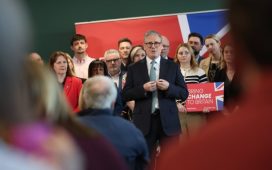Central bank officials in advanced economies are approaching the final stages in their onslaught against the global inflation shock. While recent US and European price data have shown cost pressures are abating, inflation is proving sticky.
In China, officials are reducing rates to help stimulate a weak economy that includes a slump in real estate, a drop in business investment and record-high youth unemployment.
Here are some of the charts that appeared on Bloomberg this week on the latest developments in the global economy:
US
 Bloomberg
BloombergFed officials paused following 15 months of interest-rate hikes but signaled they would likely resume tightening to cool inflation, projecting more increases than economists and investors expected. Fresh quarterly Fed forecasts showed borrowing costs rising to 5.6% by year end, according to the median projection. That’s higher than the 5.1% in the previous round of projections.
 Bloomberg
BloombergBoth the consumer price index and the core CPI — which excludes food and energy — decelerated on an annual basis, highlighting inflation’s descent since peaking last year.
Europe
 Bloomberg
BloombergThe ECB lifted interest rates by another quarter-point, with President Christine Lagarde describing a further hike in July as “very likely.” The deposit rate was raised to 3.5% on Thursday — the highest level in more than two decades. Fresh quarterly projections from the ECB suggested inflation will moderate more slowly than previously envisaged. Economic expansion in the 20-nation euro zone is seen a little weaker following recent data revealing a mild winter recession.
 Bloomberg
BloombergBritish wages shot up and unemployment fell unexpectedly in April, the latest signs that the resilient UK economy continues to defy efforts to cool demand and dampen inflationary pressures.
 Bloomberg
BloombergThe Dutch government is set to permanently shut down the Groningen gas field in October, a move that may limit Europe’s supply buffer as it heads into the next winter. The site has caused huge local opposition after hundreds of earthquakes with magnitudes of up to 3.6 damaged thousands of homes. The government previously said it aims to shut the field at the latest by Oct. 2024 depending on the “geopolitical situation.”
 Bloomberg
BloombergA shift in Britain’s mortgage market is delaying the impact of higher interest rates on the economy, increasing the risk of the Bank of England fumbling its decision on how much more it needs to do to curtail inflation.
Asia
 Bloomberg
BloombergChina’s weakening economy prompted the central bank to cut interest rates for the first time since August, and expectations are growing for more stimulus targeted at ailing industries including the property sector. Official data showed a slump in real estate, a worrying decline in business investment and record joblessness among young people.
 Bloomberg
BloombergJapan’s exports expanded at the weakest pace in over two years amid a global economic slowdown, adding to uncertainty over the country’s growth outlook. The value of exports rose 0.6% from a year earlier in May, the slowest pace since February 2021.
 Bloomberg
BloombergChina’s indebted local governments are increasingly imposing controversial fines on residents in a bid to generate revenue, stoking anger among social-media users. Guangxi alone made 13 billion yuan ($1.8 billion) from fines last year, according to an analysis of government data by Caijing Industry Research Center — equivalent to about 14% of its tax income, rising from 9% in 2021.
 Bloomberg
BloombergNew Zealand led the world in raising interest rates to combat the post-pandemic inflation wave. Now it’s officially in recession in a possible harbinger of what lies ahead for others. Gross domestic product fell 0.1% from the fourth quarter, when it dropped a revised 0.7%.
Emerging Markets
 Bloomberg
BloombergJust 30 miles (50 kilometers) offshore from Caracas lie the Western Hemisphere’s second-largest reserves of natural gas. Yet Venezuela has never exported a molecule of that fuel. Now, with the nation’s oil industry in tatters, President Nicolas Maduro is kicking off a long-shot bid to tap those vast deposits to revive an economy devastated by defaulted debt, rampant inflation and crippling US sanctions.
World
 Bloomberg
BloombergThe Fed and ECB headlined this week’s central bank meetings. The Bank of Japan decided to stick with ultra-low rates, and Taiwan’s central bankers kept their key rate on hold for the first time since 2021.










